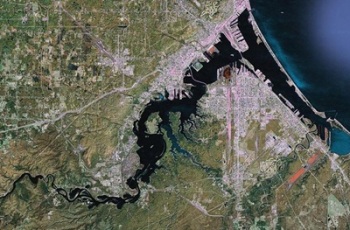 |
Canku Ota
|
 |
|
(Many Paths)
|
||
|
An Online Newsletter
Celebrating Native America
|
||
|
November 2016 - Volume
14 Number 11
|
||
|
|
||
|
Manoomin Is Coming
Back To Northern Minnesota
|
||
|
by KUOW.org
|
||
CLOQUET, MN – As close to heaven as one can get. That's how the Fond du Lac Band, of Lake Superior Chippewa, describe the St. Louis River estuary, where the river slows and widens before emptying into the Lake Superior in Duluth. "This was sort of a perfect place, a Mecca of sorts is what my uncle called it," said Thomas Howes, the band's natural resources director. "Everything that one needed for a good life was provided by the environment here." And that included wild rice, or manoomin in Ojibwe, a food that still plays a critical role in the cultural life of the Tribe's people. Decades of human activity almost eliminated wild rice from the region. But now, several agencies are partnering on a landmark effort to restore wild rice to about 250 acres of the St. Louis River estuary over the next five to 10 years. "From the time a baby is born, to when we send people off to make their journey into the afterlife, there are ceremonies, and manoomin is a central component of those," Howes said. "A lot of people say, that if we don't have that, then we cease to exist somewhat culturally as a people."
Historically, the St. Louis River estuary may have sustained 2,000 to 3,000 acres of rice, one of the richest concentrations of rice in the region. But over the past 125 years, industrial development, pollution and logging (in the late 1800s logs were transported downriver so thickly, lumberjacks could walk across them) nearly wiped wild rice out, leaving behind only a few isolated pockets. In 1978, a wastewater treatment plant went on-line, greatly improving water quality in the river. Over the years, contaminated sediment has slowly been removed from the river bottom. "We've had such great improvements in water quality over the last couple of decades, that the time is right now to begin wild rice restoration because the water quality is high enough that we can bring the wild rice back," said Daryl Peterson with the Minnesota Land Trust. Peterson's group, together with the Fond du Lac Band, Minnesota and Wisconsin DNR and other tribal agencies, is working on the current wild rice crop restoration project. While out on the St. Louis River, Charlie Nahgahnub, a tech with e Fond du Lac Natural Resources, pointed out where geese ate the rice just as it grew above the water's surface. That's a big concern for the rice moving forward, along with carp, which also like to feast on young wild rice plants. Still, Nahgahnub hopes to someday harvest rice from the St. Louis River. "There's a whole generation that doesn't know how to do this," he said. "It gives me hope, they want to revive it, restore it, to what it was." |
|||
|
|
|
|
||
|
|
||
| Canku Ota is a free Newsletter celebrating Native America, its traditions and accomplishments . We do not provide subscriber or visitor names to anyone. Some articles presented in Canku Ota may contain copyright material. We have received appropriate permissions for republishing any articles. Material appearing here is distributed without profit or monetary gain to those who have expressed an interest. This is in accordance with Title 17 U.S.C. Section 107. | ||
|
Canku Ota is a copyright ©
2000 - 2016 of Vicki Williams Barry and Paul Barry.
|
||
 |
 |
|
|
The "Canku
Ota - A Newsletter Celebrating Native America" web site and
its design is the
|
||
|
Copyright ©
1999 - 2016 of Paul C. Barry.
|
||
|
All Rights Reserved.
|
||

